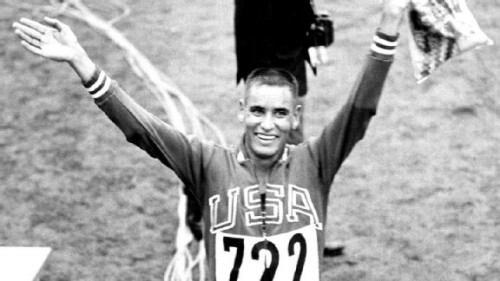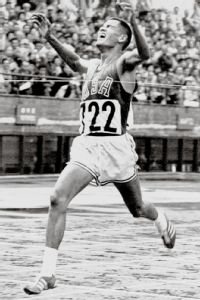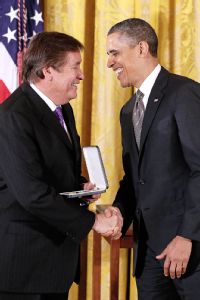Only 10,000M Olympic champ in U.S. history still helping fellow Native Americans

By Brianne Mirecki, ESPN.com
When Billy Mills raced to one of the biggest upsets in Olympic history — winning the 10,000-meter gold medal at the 1964 Tokyo Games — a lot of people wanted to congratulate him.
Mills received a telegram from his best friend, Leroy Chief, and his cousin, Harry Eagle Bull. A note from John Glenn challenged Billy, a fellow Marine, to a race – the competitive Glenn said he’d ride his motorcycle, and if he didn’t win, they’d have to race again with Glenn on his rocket ship.
But perhaps the most unique congratulation originated over 5,700 miles away from the athlete’s village in Tokyo and took a bit longer than a telegram to reach Mills.
Back on the Pine Ridge Indian Reservation where Mills had grown up, just before the race he wasn’t supposed to win, the community filled a sacred pipe with tobacco and prayed to the four directions, to mother earth and to the creator, that Billy would represent himself with dignity, and in so doing represent his people — the people of the Oglala Lakota (Sioux) tribe and the United States — with dignity.
When Mills returned home from Japan, the tribe held a powwow in his honor and bestowed upon him his Lakota name: Tamakoca Tekihila, which translates to “Loves His Country”.
It was a name Mills would live up to not just on Oct. 14, 1964, when he won the only 10,000-meter Olympic gold in U.S history, but every day since that epic race.
The Path To The Medal
The story of Mills’ journey to the Olympics reads like a Dickens novel. Born to Grace and Sidney Mills on June 30, 1938, on the Pine Ridge Reservation in South Dakota, Billy Mills joined a family that would soon number eight children. His parents divorced when he was young, but he was close with both and devastated by the death of his mother when he was 8, and especially by the loss of his father four years later.
One of Mills’ strongest memories of his father is from a fishing trip the two took shortly after his mother’s death.
“My dad looked at me and told me, ‘Son, you have broken wings.’ He said I had to look beyond the hurt, hate, jealousy, self-pity. All of those emotions destroy you. He said, ‘Look deeper son. Way down deep is where the dreams live. Find your dream, son. It’s the pursuit of a dream that’ll

heal a broken soul.'”
Mills’ environment did not lend itself to the fulfillment of dreams. Pine Ridge is consistently one of the poorest communities in the United States, and suffers from a crippling mix of complicating issues: alcohol abuse, unemployment, youth suicide and others.
Besides these immediate barriers, the native community was under legal and psychological attack from the federal government — Mills’ date of birth is closer to the massacre at Wounded Knee than it is to today, and the American Indian Religious Freedom Act wasn’t passed until 1978 — and people struggled to maintain their identity in the face of a government mandate to assimilate. He says he grew up with the knowledge that his people had experienced “our own genocide.”
Mills’ father was Oglala Lakota, but his mother was white, which means that their child is iyeska, a Lakota term which he translates as “mixed blood”. At times Mills felt held at arms length by the most traditional and full-blooded native people. Achievement, measured by accolades like academic and athletic success, sometimes seemed to come at the expense of community.
He did well enough academically to gain admission to the Haskell Indian School (now the Haskell Indian Nations University), but the school was far from his family, in Kansas, and choosing to leave the reservation brought additional scrutiny and wariness from the native people who stayed.
Mills says that those Oglala who chose to go to the school were “rejected twofold. Those traditionalists … couldn’t understand why we were trying to engage in the society that had basically created the genocide of us. And society basically rejected us. The theme of the day was the melting pot. But the melting pot, if you look at it from the Native American perspective, was to take the Indian-ness out of me.”
Running became Mills’ escape from his personal struggles. No matter what was going on in his life, when he ran, he found tranquility. At Haskell, Mills’ running prowess caught the attention of college coaches, and he entered a world even more removed from his native community when he enrolled at the University of Kansas. he seemed to be doing well, but internally he was struggling.
“Racism in America was breaking me,” he says. “Nobody knew, but it was breaking me.”
Mills says he came frighteningly close to committing suicide, “close enough to scare me to this day.” But in his darkest moment, he heard a voice.
“I just heard energy: ‘Don’t. Don’t. Don’t.’ The fourth and last time, soothing, powerful, gentle loving, very direct, ‘Don’t.’ And to me it was my dad’s voice. I got off my chair and I wrote down a dream to heal a broken soul. I wrote ‘Gold medal, 10,000 meter run.'”
Healing A Broken Soul
The journey toward his dream is an epic tale that has already been the subject of a feature film, “Running Brave.”
He found some success in college, becoming a three-time All-American in cross country, but his career really took off when he joined the Marines and married his college sweetheart, Patricia. The Marines offered stability in the form of a special training camp for Olympic hopefuls, medical expertise that identified and helped manage the Type II diabetes that had caused Billy to unexpectedly crash in previous races, and a strong mentor in the form of coach and Olympic gold medalist Tommy Thompson Sr.
Coach Thompson’s belief in Mills’ dream was a key component of his success, but even more important was the confidence and support he drew from Patricia, who put her own goal of a career in art on hold in order to support his training.
In a time when Olympic athletes were still held to the strictest definition of amateurism, Patricia was his one-woman support crew, providing meals and snacks to help manage his diabetes, caring for their newborn daughter, and providing emotional support when almost no one else believed in Mills’ dream.
In Tokyo, Mills had memorized where Patricia would be sitting before the race — 95 yards from the finish, 32 seats up. In visualizing the race, he

designated it as the point where he would start his all-out sprint. Despite going up against athletes such as Australian Ron Clarke — the reigning world record holder who had run nearly a minute faster than Mills’ personal best — Mills’ belief in himself never wavered. His goal was to win.
When the gun fired on race day, Mills hung with the leaders, despite a pace for the 10,000-meter race that was nearly as fast as his best for 5,000 meters. On the final lap, he found himself one of just three men in contention for the win, sitting on Clarke’s shoulder with Mohammed Gammoudi of Tunisia just behind him.
The bell lap played out like an obstacle course as the leaders weaved around nearly a dozen lapped runners, and Billy was pushed off balance twice in the jostling for position. Stumbling into lane 2 in the aggressive fray, Billy seemed to fade out of contention on the backstretch when Gammoudi surged. Mills approached Patricia’s seat about eight yards behind the leaders.
Coming off the curve of the straightaway, just under his wife’s position, a lapped runner began to float wide, and Mills saw daylight: space to sprint for victory. He pumped his arms, lifted his knees, and gave it all he had. Glancing left at a lapped runner, Mills thought he saw an eagle on the competitor’s singlet. He remembered his father’s words: “The pursuit of a dream will heal your broken wings.”
He flew with the wings of an eagle to the finish line, breaking the tape first.
The Giveaway
Despite dreaming about the victory for years, Mills could hardly believe his dream had come true. When an official came up to him immediately after the race and asked, “Who are you?” Mills momentarily panicked, fearing he had somehow stopped a lap early. In footage from the race, you can see him holding up one finger, asking a question.
The Japanese official confirms with a single raised finger of his own: first place, Olympic champion. Mills laughs, still seemingly disbelieving, and waves to the crowd.
What does one do then as a newly-crowned Olympic gold medalist? Mills knew generally what he wanted to do after the Olympics.
In the Lakota tradition, someone who has experienced success holds a “giveaway,” a ceremony that recognizes those who have supported them on their journey and gives back. But Mills wasn’t sure how to hold his giveaway. The tribe had been his entire existence, and he was overwhelmed by the number of people he wanted to recognize and share his victory with.
Again, Mills turned to Patricia. Her suggestion? “Take the inspiration that was given to you and pass it on to another generation.”
Since the medal ceremony in Tokyo, the rest of his life has been a choreographed giveaway. The process began in 1983, when Mills worked to create “Running Brave,” which chronicles his Olympic journey. He still meets strangers around the world who tell him they were inspired by his movie.
The giveaway started working in earnest, though, when Mills met Gene Krizek, a World War II veteran with extensive connections in Washington who had just started his Christian Relief Services charity. Concerned about the plight of Native Americans, Gene enlisted Billy’s help as a spokesperson for a new charity dedicated to bringing “resources and a sense of hope” to American Indian communities.
In honor of Mills’ achievements, the two named the charity Running Strong for American Indian Youth (http://indianyouth.org/). The charity serves the community through activities such as organic gardening initiatives, helping to weatherproof homes, funding projects to document and preserve native culture and language, and, of course, fundraising through road races.
Since 1991, Running Strong has donated more than $41 million in programs and services that benefit American Indian youth and native communities across the country. Mills’ official role with Running Strong is to serve as national spokesperson, which he does in addition to his day job as a professional speaker.
Mills is on the road for upwards of 300 days a year, speaking to diverse groups at museums, universities and in the military, his broad perspective

Billy Mills received the 2012 Presidential Citizens medal for his work with American Indian youth.
providing inspiration with which just about anyone can identify. Most of his speeches emphasize “global unity through the dignity, character and beauty of global diversity.” Billy speaks with deliberation and passion, his calm, soothing voice belying the urgency of his message.
He has a teacher’s ability to explain the wider historical context of an event or problem, and a belief in people’s ability to work together that is so strong as to be spiritual. The combined effect is to produce a broad understanding of our interconnected problems and a confidence that good people will be able to fix them. It is this spirit that inspires his latest endeavor.
Mills wanted to do something special in October in recognition of the 50th anniversary of his gold medal run. Of all the problems facing the youth of Pine Ridge and other Native American communities, he is most concerned about “the poverty of dreams”: the grind of financial poverty that can rob American Indian youth of the ability to imagine a better future and chase after their goals.
As his father said all those years ago, “it is the pursuit of a dream that will heal a broken soul.” So, the Dreamstarter project (http://indianyouth.org/Dreamstarter), launching this year, encourages young people to imagine a way to improve their community and then provides logistical and economic support for that dream.
For each of the next five years, 10 young dreamers will be selected to have their vision come true. The applicants must find a mentor organization to work with in implementing their ideas, and will participate in a leadership skills-building conference in Washington, D.C., before receiving $10,000 from Running Strong for American Indian Youth to help make their dreams a reality.
The program is notable for the agency that it provides to the grant recipients. Besides general themes for each year (this year’s theme is wellness, next year’s is the arts) and the stipulation that projects must be aimed at communities composed primarily of native people, there are few restrictions on what the dreams can entail. I
Instead of throwing money at a problem, the Dreamstarter program empowers young people to identify a problem in their communities and come up with a solution. Essentially, Mills is creating leadership.
“Loves His Country,” the name given to Mills by his tribe after his race, has a dual meaning, because as a mixed-blood iyeska, Billy has two countries and loves them both.
His love for his Lakota Sioux tribe has led him on his 50-year quest to give back to the community and improve the lives of native people in America. And his love for the United States, evidenced by his service to the federal government as a Marine and his representation of the United States as an Olympian, means he never forgets the power and responsibility that the U.S. government has as it relates to Native Americans.
As Mills says, “our young people … are going to be our warriors in the battles of the 21st century. Our battles will no longer be fought out on the plains of the Dakotas. The battles are going to be fought … with our intellect, and they’re going to be fought in the court systems of America.
“Not against the United States of America, but by educating our congressional people [on Native American treaty rights] … and fighting for the implementation of those treaty rights. [And that will] help empower Native American young people to help make America a more beautiful place.”
Through the Dreamstarter project, Mills is moving forward the process of empowerment.
This past year, while visiting a tribe in North Dakota, Mills was given a second Indian name, one that translates as, “He Whose Footsteps We Can

Giving back to Native American people is a fulfilling, ongoing process for Billy Mills.
Hear, But We Cannot See Him.” Like his original Indian name, this one has two meanings.
The first references the race where Mills dreamed of victory — 50 years ago, Billy Mills’ footsteps, so fast you could barely see him, ignited a nation, so fast you could barely see him. The second is that Mills’ footsteps, the impression he leaves behind, will last long after his life is over.
What began as a journey to heal a broken soul by chasing an Olympic dream has become a lasting legacy that enables others to join the pursuit of dreams and goals.
